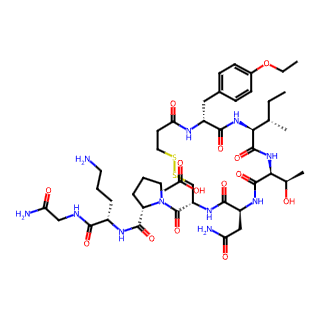- Synthetic anti-infective drugs
- Medications for the digestive system
- Antipyretic and analgesic drugs
- Medications for the blood system
- Medications for the respiratory system
- Anti-allergic drugs
- Medications for the urinary system
- Diagnostic medications
- Immunosuppressive and immunomodulatory drugs
- Vitamins and mineral supplements
- Antioxidants and medications for osteoporosis
- Antiparasitic drugs
- Ophthalmic medications
- Amino acids and their derivatives
- Dermatological medications
- Medications for the circulatory system
- Antitumor drugs
- Medications for the nervous system
- Hormonal and endocrine function-regulating drugs
- Antibiotics
- Others
CAS No.: 914453-95-5




Atosiban Acetate
Atosiban Acetate, a nonapeptide compound, is a competitive vasopressin/oxytocin receptor antagonist and a desaminooxytocin analog. It is used primarily in the medical field for its specific effects on the uterus.
Basic Information
English Name: Atosiban Acetate
CAS Number: 914453-95-5
Molecular Formula: C45H71N11O14S2
Molecular Weight: 1054.24
Pharmacological Action
Atosiban Acetate acts as a competitive antagonist of oxytocin receptors in the uterus, decidua, and fetal membranes. By binding competitively to oxytocin and vasopressin V1A receptors, it blocks the actions of oxytocin and vasopressin, resulting in reduced uterine contractions. Additionally, Atosiban Acetate inhibits uterine contractions in a dose-dependent manner and decreases oxytocin-mediated prostaglandin secretion, contributing to the preservation of pregnancy.
Clinical Applications
Atosiban Acetate is primarily used to delay imminent preterm birth. It is indicated for women aged 18 and above, with a gestational age of 24–33 weeks, and normal fetal heart rate. It is administered when regular uterine contractions occur at least four times every 30 minutes, lasting for at least 30 seconds each, accompanied by cervical dilation of 1–3 cm (0–3 cm for nulliparous women) and ≥50% cervical effacement. As the only uterine-specific tocolytic agent approved by the European Medicines Agency for the treatment of preterm birth, Atosiban Acetate demonstrates effective pregnancy preservation with high safety for both the mother and the fetus.

Tai Yau Street, San Po Kong, Kowloon, Hong Kong, China.



